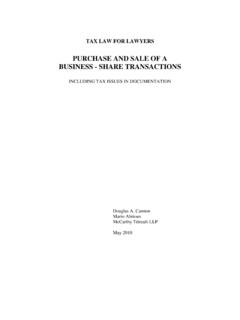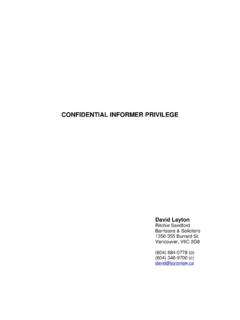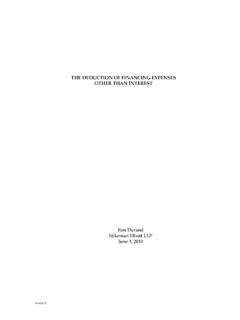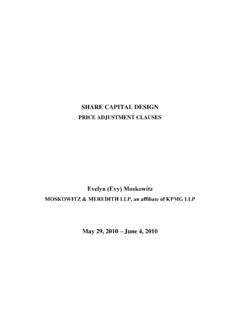Transcription of INTRODUCTION TO TAX ATTRIBUTES
1 INTRODUCTION TO TAX ATTRIBUTES . MICHAEL D. TEMPLETON. TABLE OF CONTENTS. INTRODUCTION TO TAX ATTRIBUTES .. 1. BASIC ACCOUNTING CONCEPTS .. 1. Shareholders' 1. Retained Earnings (Earned Surplus) .. 1. Contributed Surplus .. 1. STATED CAPITAL .. 1. Definition .. 1. Adjustments to Stated Capital .. 2. Adjustments .. 2. 2. Additions .. 2. PAID-UP CAPITAL .. 3. Definition .. 3. Deemed Dividends .. 4. Stock Dividends .. 4. Capitalization of 4. WHERE PUC DEPARTS FROM STATED CAPITAL .. 5. ADJUSTED COST BASE .. 9. Definition .. 9. Components of 10. V-Day Value Adjustments .. 11. Section 52 Cost 11. Adjustments to ACB .. 12. (i). Additions to ACB .. 13. Deductions from ACB .. 13. Identical Properties Rule .. 14. Negative ACB .. 15. Allocating and Manipulating ACB .. 15. DISPOSITION AND PROCEEDS OF DISPOSITION .. 17. Definition of Disposition .. 17. Definition of Proceeds of Disposition .. 18. Proceeds of Disposition of Non-Capital Property .. 19. Section 20. THE STOP-LOSS RULES .. 20. The Concept of Affiliated Person.
2 21. Specific Stop-Loss Rules .. 21. Losses on Shares that Are Capital Property and on which Dividends Have Been Received (Subsection 112(3)) .. 22. (ii). BASIC ACCOUNTING CONCEPTS. Shareholders' Equity The shareholders' equity account on a corporation's balance sheet represents the value of assets less liabilities. Shareholders' equity consists of three accounts - share capital, contributed surplus (if any) and retained earnings. Retained Earnings (Earned Surplus). Retained Earnings represent accumulated undistributed income net of any losses, miscellaneous charges and dividend payments. Contributed Surplus Where contributions are made to a corporation and these contributions are not added to a particular stated capital account, such amount is generally added to contributed surplus. The CICA defines contributed surplus as: 1. Surplus contributed by shareholders, being the premium received on the issue of par value shares, the portion of proceeds of issue of no par value shares that has been allocated to surplus, the proceeds of sale of donated shares, profit on forfeited shares, credits resulting from redemption or conversion of shares at less than the amount set up as share capital or any other contributions in excess of stated value of shares made by shareholders as such.
3 2. Capital donations from sources other than shareholders. STATED CAPITAL. Definition The term stated capital relates to the amount of consideration that a corporation receives for the issuance of its shares. The composition of share capital under corporate law depends on the jurisdiction of incorporation. Where par value shares ( : a fixed value per share that a company has chosen in its incorporating documents) are permitted, the stated capital of a class will be its aggregate par value. Par value shares are permitted under provincial legislation in British Columbia, Nova Scotia, Prince Edward Island, New Brunswick and Quebec. A par value share may not be issued for less than its par value, but may be issued for more. Any amount received on the issue of par value shares in excess of par value is not included in stated capital but is added to contributed surplus. -2- Under the Canada Business Corporations Act ( CBCA ) and legislation under Alberta, Ontario, Manitoba, Saskatchewan, Newfoundland, the Northwest Territories and the Yukon, shares are to be issued without nominal or par value.
4 The stated capital of shares issued without par value is the amount of consideration that the corporation receives for the issue of such shares, subject to the adjustments described below. The CBCA provides that a corporation must maintain a separate stated capital account for each class and series of shares that it issues (subsection 26(1)). Shares are not to be issued until full consideration is received for the share in money, property or past service that is not less in value than the fair market value of the share (subsection 25(3)). Where property or past services are paid as consideration for shares, the dollar value of the property or services is added to the stated capital account. Adjustments to Stated Capital Adjustments A corporation under the CBCA (subsection 26(3)) is permitted, in certain non-arm's length transactions and pursuant to certain amalgamation agreements, to add to stated capital an amount that is less than the consideration received for the shares issued pursuant to the transaction.
5 This provision under the CBCA allows for the issuance of high-low shares which have a low paid-up capital and high redemption amount. High-low shares are often used for tax purposes to convert what would have been a capital gain into a deemed dividend, as dividends are generally received tax-free between Canadian corporations. Any changes to stated capital should take into account corporate solvency tests in the applicable provincial legislation. Reductions Stated capital may be reduced under subsection 38(1) of the CBCA for the purpose of (i). reducing or extinguishing liabilities in respect of an amount unpaid on any share, (ii) making a distribution to a shareholder; and (iii) reducing stated capital by an amount that is not represented by realizable assets. When a corporation purchases or redeems its own shares, the corporation (under subsection 39(1) of the CBCA) must reduce its stated capital for the particular class or series of shares being redeemed on a pro-rata basis. Additions Share capital of a corporation may be increased under subsection 26(4) of the CBCA by adding the amount of consideration received by it for the issued shares (as discussed above).
6 Share capital may also be increased by special resolution to add an amount that the corporation credited to retained earnings or other surplus accounts (subsection 26(5)). -3- PAID-UP CAPITAL. Definition Paid-up capital ( PUC ) is the expression used by the Income Tax Act (Canada) (the Act ) to refer to the capital concept. In general, PUC may be returned to shareholders of a corporation, including non-resident shareholders, free of tax. All other corporate distributions are either dividends or taxable shareholder benefits. PUC is therefore relevant in determining the tax consequences of corporate reorganizations, distributions and dissolutions. Where a private corporation1 returns cash to its shareholders other than by way of redemption, the directors may choose to pay the shareholders by way of a dividend or a tax-free return of capital. Tax law in the , by contrast, generally provides that any distribution (however characterized) will be treated as a dividend to the extent the corporation has undistributed earnings or profits at the time of the distribution.
7 The starting point for the computation of the PUC of a class of shares is the stated capital 2. of the class for corporate law purposes. The PUC of a class of shares is equal to its stated capital, plus or minus certain adjustments specified in the Act. The adjustments are generally designed to prevent a corporation from using tax-deferred transactions to increase the stated capital of the corporation and thereby obtain an increased PUC. While stated capital is a cumulative amount calculated in relation to a class or series of shares, the value of PUC must be determined for a particular share. The PUC of a share of a particular class is calculated by dividing the PUC for the particular class by the number of issued shares in the class. All the shares of a particular class will have the same PUC per share. Consequently, as a corporation issues new shares (of the same class), the PUC of the existing shareholders will vary unless the shares are always issued for the same price. For example, if a corporation issues its initial 100 common shares for $100 (a fairly common practice) the PUC of each share will be $1.
8 If the corporation subsequently increases in value and issues a further 200. shares to new investors for $20,000, the PUC per share will be $ ($20,100 300). The original investors who started with a PUC of $100 for 100 shares, without any additional investment, would then have a total PUC of $6,700. The new investors after purchasing 200. shares for $20,000 will have a total PUC of only $13,400. To avoid this problem, private corporations will utilize a new class of shares similar to the existing class for new share issuances, so that the PUC's of different share issues are not averaged. 1. Subsection 84( ) deems a return of capital by a public corporation to be the payment of a dividend except when it occurs by way of the purchase, cancellation or redemption of shares, a transaction described in subsection 84(2) or section 86 or the reduction arises from the distribution of proceeds realized by the corporation from a transaction that occurred outside the ordinary course of business within the previous 24 months.
9 2. Definition of PUC , subsection 89(1). See also IT-463R2. The Act and the bulletin refer to the PUC of a corporation determined without reference to the Act (except the specified provisions). However, most corporate statutes do not refer to the concept of PUC and it is generally accepted that the reference to PUC determined without reference to the Act means stated capital or the equivalent term used in the relevant corporate statute. -4- A corporation's balance sheet generally reflects the amount of stated capital in the corporation. While a corporation's stated capital may equal its PUC, there are certain situations where the two amounts could be different. For example, on the transfer of assets in exchange for shares under section 85 of the Act, paragraph 85( )(a) of the Act requires that the increase in PUC from the issue of the shares be reduced where the amount added to PUC exceeds the agreed amount under the subsection 85(1) election (such reduction is generally referred to as a PUC.)
10 Grind ). In that case, the amount added to stated capital would exceed the amount added to PUC. as determined under the Act. In these circumstances, it is often advisable for corporate counsel to utilize subsection 26(3) of the CBCA to add a lesser amount to the stated capital account of the corporation to keep the stated capital and PUC equal. Deemed Dividends In general, any amount received by a shareholder from the corporation in excess of PUC. will be taxed in the shareholder's hands as a deemed dividend. Section 84 provides rules that deem a dividend to have been paid by a corporation and received by a shareholder when the corporation increases PUC without correspondingly increasing its net asset value (subject to certain exceptions). Subsection 84(1) provides exceptions to the deemed dividend provisions arising upon an increase in PUC where (i) stock dividends are issued (paragraph 84(1)(a)); (ii) the increase in PUC in one class of shares is offset by a decrease in PUC in another class of shares (paragraph 84(1)(c)); and (iii) on a capitalization of contributed surplus (paragraph 84(1)( )).












